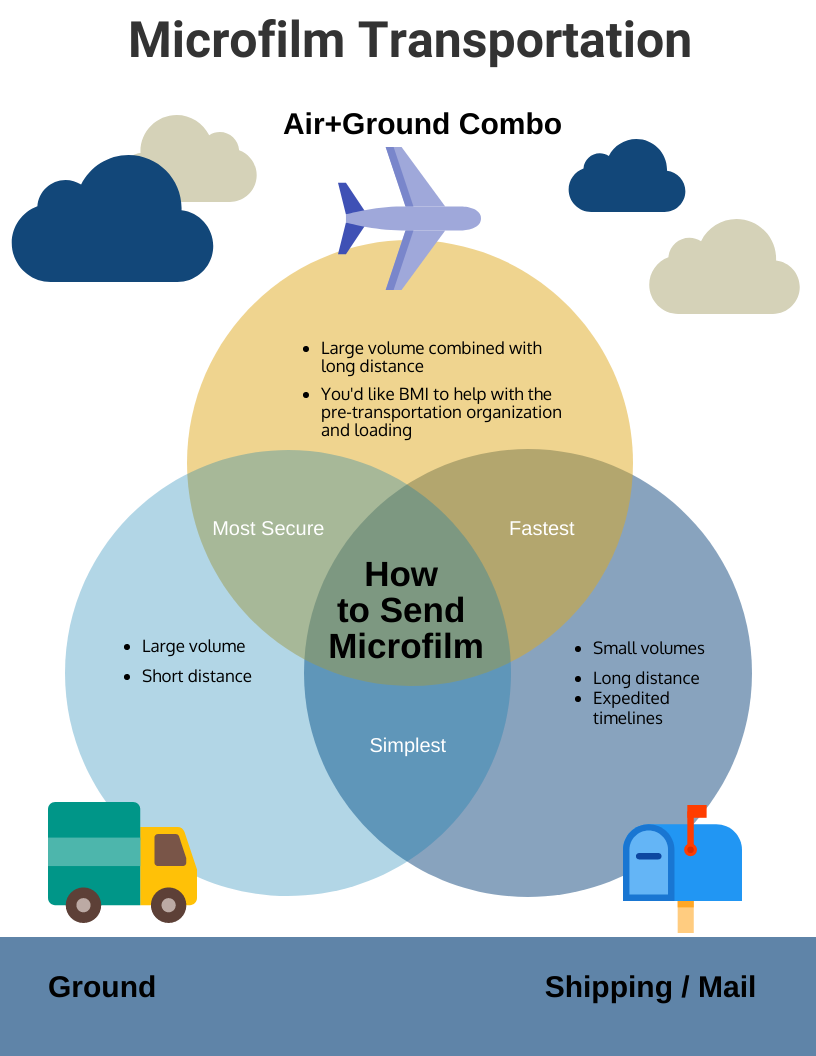We’re a company with two facilities in California. Why does this matter? Because we have clients from not only the state of California, but from across the entire country. With our facilities solely on the west coast, one of the most common questions we get asked when discussing a digital project is “how do I get my microfilm to you?” In this article we’ll give you the top three methods of getting microfilm to us, describe when a certain method makes the most sense, and provide some suggestions on how to pick what’s best for you.
Most importantly, the best transportation method is the one that you’re most comfortable with. This decision isn’t up to us, although we’ll try and help as best we can. But at the end of the day you’re the one that has to make the decision, so make sure you get a warm and fuzzy feeling before you send your microfilm out to be digitally scanned.

1. Shipping / Mailing Via Third Party
Nowadays we can order almost anything online and have it shipped to us, a lot of times within just a few days after ordering it. We’re not only talking about tchotchkes here; items that cost 100s or 1000s of dollars are constantly floating around the shipping world and we don’t think twice about it.
It should be no surprise that shipping / mailing is one of the most preferred methods of sending microfilm to a company for into . We all know the names of the big such as UPS, FedEx, and USPS, and it’s familiar, easy, and fast. Depending on where you’re sending from and the amount of material you’re sending, it’s also often the cheapest. What’s the bad part? Once you send it, it’s out of your hands and you aren’t 100% sure it’s safe until your arrive at our door.
If you’re looking for extra security for your microfilm, we offer you the option of using our lockable containers, if ; Pelican Cases are part of our shipping / container suite. We don’t guarantee that the plane won’t go down, or the truck with your won’t get swiped by a gas tanker and explode, obliterating your and , but if you’re looking for that bit of extra security and tamper-prevention, these containers could be for you. The general goes like this: we send the cases to you with a key, you put your film in, lock it and keep the key, send it back, and we open it with our key. So on and so on until we’ve converted all of your film and into .
When Does This Make The Most Sense?
2. Ground Transportation
Yes, ground transportation can technically be associated with third party shipping, but when we say ground transportation here we mean it in one of the following ways:
BMI picks it up
We work with you to set up a pickup or delivery and have our driver(s) go to your location in a BMI-owned van. This is mostly used for /regional pickups and deliveries because once you get past a certain distance, it starts to not make sense for this mode of transportation.
Not to say we can’t drive longer distances if the project warrants it, but driving across multiple states is usually reserved for projects that have various reasons to do so, such as very large volumes, extremely sensitive or fragile material, or some contingent factor.
You drop it off
As easy as it sounds! If you’re able, you’re always welcome to drop off your microfilm at the beginning of your project, and then pick it up when the project’s complete and ready for you. Although it takes some time out of your day, we actually love having our customers do this because it gives them a chance to come to our facilities and take a tour. If you have the chance and are interested in seeing what goes on in a digital and information management company’s workplace, we invite you to be our guest.
You send via courier
We have handfuls of customers who like to use trusted couriers, and it’s easy for everyone because neither party (our customers or us) has to do any of the driving. It might be a little more expensive for you if you go this direction, but it’s a balancing act of spending your time or your money to get your to us.
When Does This Make The Most Sense?
Ground transportation, for the of this article and according to us, makes the most sense when you’re in our or regional . It’s simple to get taken care of and, because of the geographic closeness to our , is usually very flexible when coordinating. Sometimes we may be able to pick up the next day after getting a contract signed!
3. Air + Ground Transportation
Snapshot: BMI flies to your location, rents a freight truck, drives your material back.
This may not seem like a common method of getting your film to us, but in our world it kind of is. For many projects that are just a little past the point of it making sense to have one of our drivers wheel it on up the road to your location (multiple days of driving), or for a project with volumes of material that exceed the capacity of our company trucks, this is one of the best methods to collect your microfilm and get it back to our facility.
It’s simple, really. A BMI employee (who has the proper license classifications for freight trucks) books a flight to the airport nearest to your location, or wherever your microfilm is stored. Then he’ll rent a truck suited to the transportation and will pick up the material and drive back to our facility for the project. Done! If it’s a long enough drive, we’ll have two employees on the trip so that they can switch off driving while the other sleeps.
If there’s microfilm that’ll fit in one pickup, he’ll get a truck big enough for the one, but if there’s just way too much film then we’ll work with you to determine how many batches we’ll be doing and get the right truck for the batch sizes. Take a look at our article that covers reverse engineering your project to get an idea about batch sizes, timelines, and so on.
Wondering what we do when it’s nighttime? We keep driving. Your material doesn’t sit overnight in a truck in a random parking lot at the Bates Motel. We know your concern, and we’ve got you covered.
When Does This Make The Most Sense?
The flight/truck combo makes the most sense in situations where the project material isn’t easily shipped and it’s too far for a drive both ways. If you think about it from our perspective, it’s a lot less expensive to buy a $100 plane flight that takes a few hours, rent a truck and drive back with your material instead of spending all that time on the road with an empty vehicle. It’s also faster.
This method of transportation is usually for projects on the larger side, too, because if it’s a small or medium-sized project that can safely be mailed, we’ll usually recommend that. Once the costs start outweighing the benefits of mailing your material to us is when we get into discussions about the flight/truck combo method.
Final note on this method of transporation: most times that we’ve used this option for transporting a project, we were also involved in the pre-transportation organization and loading of our client’s material. When there’s a big project in the works that requires this mode of getting film from a client to us, it’s usually worth having one of our solid employees on site to assist our client. By doing this we can get a step ahead in the project and sort of guide the project down the best path right out the gate.
Next Steps
Reach out to us today! Click the “Get Your Quote” button below, fill out the form, and we’ll quickly reply to you to discuss your project.
Further Reading
Here are three additional articles you can check out to learn more about microfilm scanning and digitization:
“How To Prepare Your Microfilm For ” is a pre- project guide that’ll help you get your microfilm ready before you send it to a company for . We use the acronym TIPs to remember the three parts (Triage, Inventory, Pack).
“Digitization & The Chain Of Custody” describes the importance of tracking your records during a conversion project. When you send us your microfilm to be scanned, you’ll know that they’re tracked properly and in good hands.
“The BMI Microfilm Scanning Process” is our 10-step process to take your microfilm from hard copy to digital. Every company has their own method, and we’re happy to show you ours!

